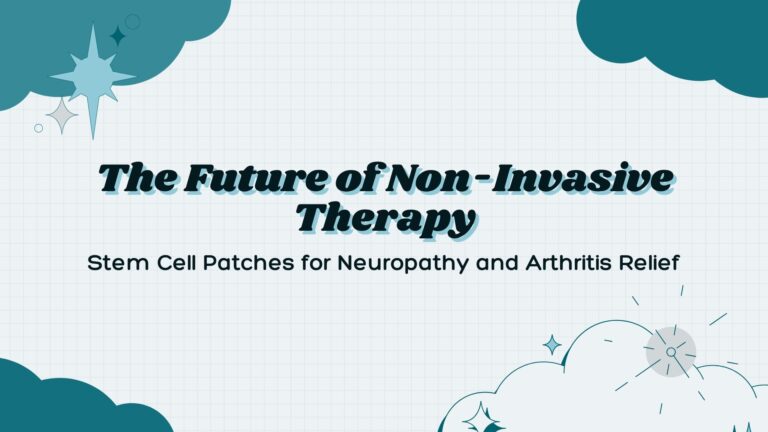Stem Cell Patches and Cancer: Preliminary Research and Future Directions
Introduction
Stem cell patches represent a cutting-edge approach in medical science, promising innovative solutions for a variety of health conditions, including cancer and arthritis. These patches are garnering attention for their potential to activate a body’s natural healing processes. This article delves into the preliminary research around stem cell patches and their future directions, focusing on their application for treating cancer. We will explore the science, recent findings, and what the future might hold, all packed with actionable advice and data-driven insights.
What Are Stem Cell Patches?
Stem cell patches are a revolutionary concept in regenerative medicine. They contain stem cells or growth factors that stimulate the body’s own stem cells, aiding in the repair and regeneration of damaged tissues. These patches are easy to apply, making them a convenient and less invasive option compared to traditional treatments.
Stem cells have the remarkable potential to develop into different types of cells, such as muscle cells, bone cells, or brain cells. This adaptability makes them invaluable for various medical applications.
Pro Tip: Always consult a healthcare professional to understand if stem cell patches are suitable for your specific condition.
Stem Cell Patches for Arthritis
How They Work
Stem cell activation patches for arthritis work by promoting the repair and regeneration of damaged cartilage and tissues in the joints. They deliver growth factors and stem cells directly to the affected area, enhancing the natural healing process.
Research has shown that these patches can reduce pain and inflammation, improving mobility and the quality of life for arthritis patients.
Clinical Studies and Findings
Various clinical studies have demonstrated the effectiveness of stem cell patches in treating arthritis. One study reported that patients experienced significant pain relief and improved joint function within a few weeks of using the patches.
Another study involving animals showed the regeneration of cartilage and reduced arthritis symptoms, providing hope for similar results in human trials.
Cancer Treatment: The Role of Stem Cell Patches
Mechanism of Action
Stem cell patches for cancer treatment aim to use the regenerative potential of stem cells to target and destroy cancer cells while sparing healthy cells. These patches can deliver therapeutic agents directly to the tumor site, increasing the effectiveness of the treatment and minimizing side effects.
Pro Tip: Combining stem cell patches with traditional cancer treatments like chemotherapy can potentially enhance the overall therapeutic outcome.
Preliminary Research and Success Stories
Early research indicates that stem cell patches could be a game-changer in cancer treatment. In a preliminary study, researchers observed that the patches helped shrink tumors in mice without damaging healthy tissues.
Several success stories have emerged, showcasing patients who benefited from this innovative treatment approach. These cases provide a glimpse of the potential breakthroughs that stem cell patches could bring to cancer treatment.
Limitations and Challenges
While promising, stem cell patches for cancer treatment are not without challenges. One major limitation is the potential for immune rejection, where the body’s immune system attacks the introduced stem cells.
Another challenge is ensuring the consistent delivery of therapeutic agents. Despite these obstacles, ongoing research is addressing these issues to make stem cell patches a more viable and effective treatment option.
Future Research Directions
Enhanced Delivery Systems
To maximize the effectiveness of stem cell patches, future research is focusing on developing advanced delivery systems. These systems aim to improve the precision and efficiency of delivering therapeutic agents to the target site.
Innovative technologies such as nanotechnology and bioengineering are being explored to enhance the delivery and targeting capabilities of stem cell patches.
Pro Tip: Stay updated with the latest research developments in stem cell technology to understand the potential future applications in various medical fields.
Personalized Medicine
Personalized medicine is a promising avenue for the future of stem cell patches. By tailoring the treatment to the individual patient’s genetic makeup and specific condition, personalized medicine can significantly improve the efficacy and outcomes of stem cell therapies.
Researchers are working on developing customized stem cell patches that can address unique patient needs and optimize therapeutic results.
Conclusion
Stem cell patches hold immense promise for treating various conditions, including cancer and arthritis. While preliminary research is encouraging, further studies and advancements are needed to unlock their full potential. By continuing to explore innovative delivery systems and personalized medicine approaches, we can look forward to a future where stem cell patches become a mainstream treatment option.
To discover more about stem cell patches and consider adding them to your treatment regimen, visit our online store.
“`



